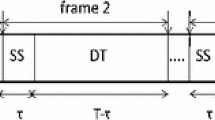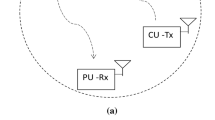Abstract
In a cognitive radio (CR) system based on energy detection spectrum sensing scheme, the threshold is mainly selected, either under a given detection probability of \(\overline{{P_{d} }}\) known as the constant detection rate (CDR) principle, or under the given false alarm probability of \(\overline{{P_{fa} }}\), known as the constant false alarm rate (CFAR) principle. In order to promise sufficient quality of service (QoS) to the licensed users, the threshold selection under the CDR principle is most favorable. However, this undesirably degrades throughput of the cognitive users, mainly under the most suitable conditions of spectrum reuse when the licensed user is located far away from the sensing node where chances of interference are negligible. To improve the licensed spectrum utilization, this paper proposes a technique for the selection of threshold based on the opportunistic use of CDR and CFAR principles depending upon the distance d of licensed user from the unlicensed one. Under the proposed approach, when the distance d is less than or equal to a formulated critical distance d c (d ≤ d c ), then, to promise sufficient QoS to the licensed users, the CDR principle is used. But for the reverse case d > d c , to maximum exploit the spectrum reuse conditions, the advantages of CFAR principle are relished. The CR system under the proposed approach obtains a significant gain in its throughput compared to the case where CDR principle is used blindly.












Similar content being viewed by others
Notes
Depending on the values of parameters assumed, the critical distance d c may change accordingly.
Due to properties of Q function \(Q\left( x \right)\), sharp variations are shown only for a range \(x \in \left( { - 3, 3} \right)\), and beyond this, the variations are very small to notice. So, for a range of variable on the x-axis, the unnoticeable variations are shown in the simulation graph of Figs. 3, 4 and 5.
References
Federal Communications Commission. (2002, Nov.). Spectrum policy task force report. FCC 02-155.
Mitola, J., & Maguire, G. Q. (1999). Cognitive radio: Making software radios more personal. IEEE Personal Communications, 6, 13–18.
Liang, Y. C., Zeng, Y., et al. (2007). Sensing throughput tradeoff for cognitive radio networks. In IEEE international conference on communications (ICC) (pp. 5330–5335).
Liang, Y. C., Zeng, Y., et al. (2008). Sensing throughput tradeoff for cognitive radio networks. IEEE Transactions on Wireless Communications, 7(4), 1326–1337.
Verma, G., & Sahu, O. P. (2015). Interference aware optimization of throughput in cognitive radio system. Defence Science Journal, 65(4), 312–318.
Stotas, S., & Nallanathan, A. (2010). Overcoming the sensing-throughput tradeoff in cognitive radio networks. In IEEE international conference on communications (ICC) (pp. 1–5). doi:10.1109/ICC.2010.5502792.
Stotas, S., & Nallanathan, A. (2012). On the throughput and spectrum sensing enhancement of opportunistic spectrum access cognitive radio networks. IEEE Transactions On Wireless Communications, 11(1), 97–101.
Pandit, S., & Singh, G. (2013). Throughput maximization with reduced data loss rate in cognitive radio network. Telecommunication Systems,. doi:10.1007/s11235-013-9858-z.
Stotas, S., & Nallanathan, A. (2010). On the throughput maximization of spectrum sharing cognitive radio networks. In IEEE Global Telecommunications Conference (GLOBECOM) (pp. 1–5). doi:10.1109/GLOCOM.2010.5683516.
Federal Communications Commission. (2002, Nov.). Spectrum policy task force report. FCC 02-155.
Verma, G., & Sahu, O. P. (2016). Intelligent selection of threshold in cognitive radio system. Telecommunication systems,. doi:10.1007/s11235-016-0141-y.
Stotas, S., & Nallanathan, A. (2011). Enhancing the capacity of spectrum sharing cognitive radio networks. IEEE Transactions on Vehicular Technology, 60(8), 3768–3779.
Xie, J. Q., & Chen, J. (2012). An adaptive double-threshold spectrum sensing algorithm under noise uncertainty. In IEEE 12th international conference on computer and information technology (CIT) (pp. 824–827). doi:10.1109/CIT.2012.171.
Liu, S.-Q., et al. (2012). Hierarchical cooperative spectrum sensing based on double thresholds energy detection. IEEE Communications Letters, 16(7), 1096–1099.
Wu, J., et al. (2009). An energy detection algorithm based on double-threshold in cognitive radio systems. In IEEE, 1st international conference on information science and engineering (ICISE) (pp. 493–496). doi:10.1109/ICISE.2009.257.
Digham, F., et al. (2007). On the energy detection of unknown signal over fading channels. IEEE Transactions on Communications, 55(1), 21–24.
Kay, S. M. (1998). Fundamentals of statistical signal processing. Volume 2: Detection theory. Upper Saddle River, NJ: Prentice-Hall.
Khalid, L. (2014). Efficient techniques for cooperative spectrum sensing in cognitive radio networks. PhD Thesis, Department of Electrical and Computer Engineering, Ryerson University, Toronto, ON, Canada, pp. 1–206.
Wang, N., et al. (2013). Adaptive spectrum sensing algorithm under different primary user utilizations. IEEE Communications Letters, 17(9), 1838–1841.
Mariani, A., et al. (2011). Effects of noise power estimation on energy detection for cognitive radio applications. IEEE Transactions on Communications, 59(12), 3410–3420.
Ye, Z., et al. (2008). Energy detection using estimated noise variance for spectrum sensing in cognitive radio networks. In IEEE conference on wireless communications and networking conference (WCNC) (pp. 711–716).
Cabric, D., et al. (2006). Experimental study of spectrum sensing based on energy detection and network cooperation. In Proceedings of international technology and policy for accessing spectrum.
Moghimi, F., et al. (2009). Lp-norm spectrum sensing for cognitive radio networks impaired by non-gaussian noise. In Proceedings of IEEE conference, GLOBECOM (pp. 1–6).
Ghasemi, A., & Sousa, E. S. (2007). Fundamental limits of spectrum-sharing in fading environments. IEEE Transactions on Wireless Communications, 6(2), 649–658.
Musavian, L., & Aissa, S. (2007). Ergodic and outage capacities of spectrum-sharing systems in fading channels. In Proceedings of IEEE global telecommunications (GLOBECOM) Conference (pp. 3327–3331).
Peh, E. C. Y., et al. (2009). Optimization of cooperative sensing in cognitive radio networks: A sensing-throughput tradeoff view. IEEE Transactions on Vehicular Technology, 58(9), 5294–5299.
Verma, G., & Sahu, O. P. (2015). Throughput Enhancement to the cognitive radio networks under the precaution is better than the cure approach (PBC). In Proceedings of IEEE international conference on signal processing and communication engineering systems (SPACES), K.L. University (pp. 1–4).
Verma, G., & Sahu, O. P. (2015). Throughput enhancement to the cognitive radio networks under the precaution based cooperation of the primary users. In Proceedings of IEEE international conference on signal processing, informatics, communication and energy systems (SPICES), NIT Calicut, Kerala (pp. 1–4).
Zhang, W., et al. (2009). Optimization of cooperative spectrum sensing with energy detection in cognitive radio networks. IEEE Transactions on Wireless Communications, 8(12), 5761–5766.
Huang, T., & Li, J. (2013). A weighted cooperative spectrum sensing scheme based on dynamic double energy thresholds in cognitive radio networks. In IEEE conference, global high tech congress on electronics (GHTCE) (pp. 201–204).
Sonnenschien, A., & Fishman, P. M. (1992). Radiometric detection of spread spectrum signals in noise of uncertain power. IEEE Transactions on Aerospace and Electronic Systems, 28(3), 654–660.
Werner, J., et al. (2013). Estimating the primary user location and transmit power in cognitive radio systems using extended kalman filters. In IEEE international conference on wireless on-demand network systems and services (WONS) (pp. 68–73).
Radhi, N., et al. (2011). Estimate primary user localization using cognitive radio networks. In IEEE international conference on innovations in information technology (IIT) (pp. 381–385).
Xiao, L., et al. (2007). Sensor-assisted localization in cellular systems. IEEE Transactions on Wireless Communications, 6(12), 4244–4248.
Wang, J., et al. (2010). Weighted centroid algorithm for estimating primary user location: Theoretical analysis and distributed implementation. pp. 1–25. arXiv:1011.2313.
Lin, Y.-E., et al. (2013). On using interference-aware spectrum sensing for dynamic spectrum access in cognitive radio networks. IEEE Transactions on Mobile Computing, 12(3), 461–474.
Wild, B., et al. (2005). Detecting primary receivers for cognitive radio applications. In IEEE symposium on new frontiers in dynamic spectrum access networks (DySPAN) (pp. 124–130).
Author information
Authors and Affiliations
Corresponding author
Rights and permissions
About this article
Cite this article
Verma, G., Sahu, O.P. Opportunistic Selection of Threshold in Cognitive Radio Networks. Wireless Pers Commun 92, 711–726 (2017). https://doi.org/10.1007/s11277-016-3573-5
Published:
Issue Date:
DOI: https://doi.org/10.1007/s11277-016-3573-5




